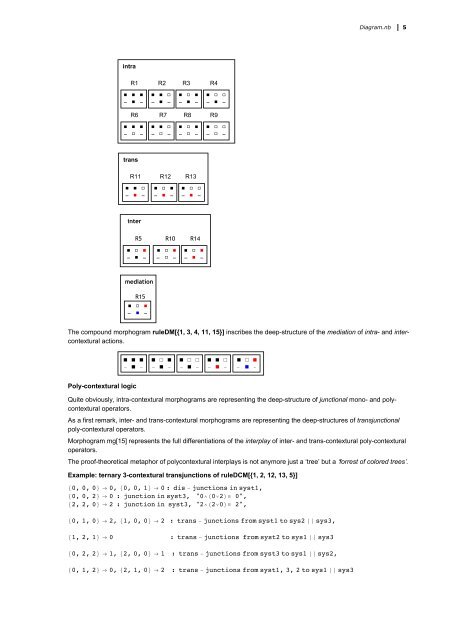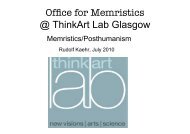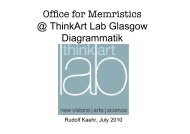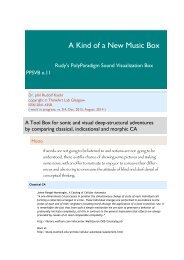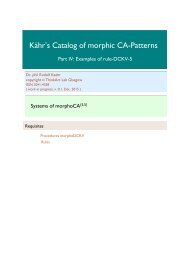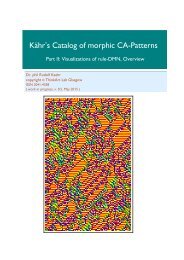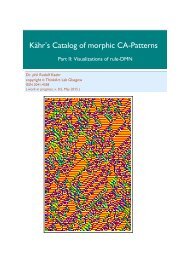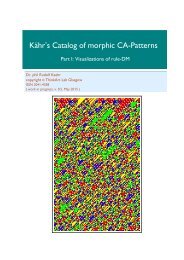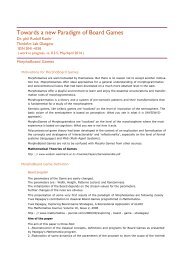Metaphors of Dissemination and Interaction of morphoCAs
Meta-theoretical considerations about the behavior of morphic cellular automata are sketched. Different types of flow diagrams for morphoCAs are distinguished: 1. mono-contextural, 2. interactional/transactional and 3. mediational poly-contextural types. Those thematizations are offering a better understanding of the nature of morphic cellular automata.
Meta-theoretical considerations about the behavior of morphic cellular automata are sketched. Different types of flow diagrams for morphoCAs are distinguished: 1. mono-contextural, 2. interactional/transactional and 3. mediational poly-contextural types. Those thematizations are offering a better understanding of the nature of morphic cellular automata.
You also want an ePaper? Increase the reach of your titles
YUMPU automatically turns print PDFs into web optimized ePapers that Google loves.
Diagram.nb 5<br />
intra<br />
R1 R2 R3 R4<br />
■ ■ ■<br />
- ■ -<br />
■ ■ □<br />
- ■ -<br />
■ □ ■<br />
- ■ -<br />
■ □ □<br />
- ■ -<br />
R6 R7 R8 R9<br />
■ ■ ■<br />
- □ -<br />
■ ■ □<br />
- □ -<br />
■ □ ■<br />
- □ -<br />
■ □ □<br />
- □ -<br />
trans<br />
R11 R12 R13<br />
■ ■ □<br />
- ■ -<br />
■ □ ■<br />
- ■ -<br />
■ □ □<br />
- ■ -<br />
inter<br />
R5 R10 R14<br />
■ □ ■<br />
- ■ -<br />
■ □ ■<br />
- □ -<br />
■ □ ■<br />
- ■ -<br />
mediation<br />
R15<br />
■ □ ■<br />
- ■ -<br />
The compound morphogram ruleDM[{1, 3, 4, 11, 15}] inscribes the deep-structure <strong>of</strong> the mediation <strong>of</strong> intra- <strong>and</strong> intercontextural<br />
actions.<br />
■ ■ ■<br />
- ■ -<br />
■ □ ■<br />
- ■ -<br />
■ □ □<br />
- ■ -<br />
■ ■ □<br />
- ■ -<br />
■ □ ■<br />
- ■ -<br />
Poly-contextural logic<br />
Quite obviously, intra-contextural morphograms are representing the deep-structure <strong>of</strong> junctional mono- <strong>and</strong> polycontextural<br />
operators.<br />
As a first remark, inter- <strong>and</strong> trans-contextural morphograms are representing the deep-structures <strong>of</strong> transjunctional<br />
poly-contextural operators.<br />
Morphogram mg[15] represents the full differentiations <strong>of</strong> the interplay <strong>of</strong> inter- <strong>and</strong> trans-contextural poly-contextural<br />
operators.<br />
The pro<strong>of</strong>-theoretical metaphor <strong>of</strong> polycontextural interplays is not anymore just a ‘tree’ but a ‘forrest <strong>of</strong> colored trees’.<br />
Example: ternary 3-contextural transjunctions <strong>of</strong> ruleDCM[{1, 2, 12, 13, 5}]<br />
{0, 0, 0} → 0, {0, 0, 1} → 0 : dis - junctions in syst1,<br />
{0, 0, 2} → 0 : junction in syst3, "0⋀(0⋁2)≡ 0",<br />
{2, 2, 0} → 2 : junction in syst3, "2⋀(2⋁0)≡ 2",<br />
{0, 1, 0} → 2, {1, 0, 0} → 2 : trans - junctions from syst1 to sys2 || sys3,<br />
{1, 2, 1} → 0 : trans - junctions from syst2 to sys1 || sys3<br />
{0, 2, 2} → 1, {2, 0, 0} → 1 : trans - junctions from syst3 to sys1 || sys2,<br />
{0, 1, 2} → 0, {2, 1, 0} → 2 : trans - junctions from syst1, 3, 2 to sys1 || sys3<br />
1. Mono-contextural diagrams: ECA <strong>and</strong> morphoCA (m,2,n)


